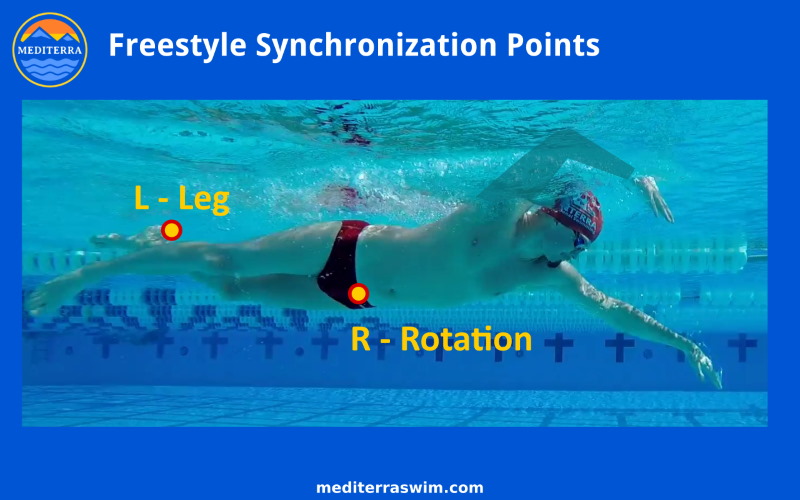How Can We Help?
Intro to Sync Combo: Leg Press and Rotation

You can begin to synchronize the leg press with the rotation once you have the arms synchronized in front, because the leg motion is ultimately going to connect to the arms through the torso. Without that timing in front, the legs will have a hard time finding the 2BP rhythm in the rear. But before you connect those distant points, you will first work on connecting the press of the leg with the rotation.
Before the rotation, you may appreciate how the foot has been positioned in the Counter-Balanced Leg Position, poised, ready to press. Notice in the image above how the Streamline side of the body is down, while the Streamline side heel is up, near the surface. The raised position of the streamline side leg and the downward pointing leg of the other side are counter-balancing the body’s rotated position in front. The leg is ready to push downward so that the Streamline side of the body can rotate upward. The press of the leg offers support, it offers leverage to help the rotation go with a bit more power.
As with the fine tuning of the arm overlap, the timing of the leg has a little room for adjustment according to the tempo of the stroke. At slower tempos, the leg will press a moment after the torso has begun to rotate. At slower tempos, the press of the leg feels like it is helping to finish the rotation. At very fast tempos, the leg will press at the same moment the torso begins to rotate. In this case, it may feel like the press of the leg is helping to start the torso rotation. This is very helpful when working at sprinting tempos, where it is harder to keep the torso rotating back and forth to keep up with the demanding tempo.
Instructions
Step 1: Down-Up Leg-Torso Connection
Use the press of the leg to help rotate the same side of the torso upward toward the surface. The leg is moving down and the side is moving up in response. This is the simple down-up connection. Notice in the image above, how the foot is now down and the hip of the same side is on its way up toward the surface.
And, it will be helpful to practice working just one leg, one side repetitiously. Remember that the 2BP is just one foot pressing in one arcing path. The other foot is not pulling, it is just drifting back in the opposite direction. So practice working just one leg at a time, over and over again, while the other practices holding pointed toes.
Step 2: Use Hip Torque
As instructed in our Intro to the 2 Beat Leg Press, now notice how the turn of the ankle corresponds to the turn of the rotation. Rather than bending the knee and pushing with the thigh, keep the knee fairly straight (allow the slightest flex) and twist your ankle in order to activate torque in the hip socket. Create that ‘Crescent Moon’ pathway with your toes. This is the more effective way to direct the press of the leg. By arcing the toes from ‘pigeon toe’ inward to ‘toes outward’ this action torques the hip joint, urging the whole torso to rotate with it. This is how you genuinely generate a ‘hip-driven’ kick. Use the torque of the muscles surrounding the hip joint, rather than pressing downward with the thigh muscles as you would with a normal flutter kick.
Review the 2BP drill videos in the Knowledge Base to tune up how you perform the kick action.
Step 3: Refine The Timing Per Tempo
Since each swimmer’s functional tempo range is a bit different from any other’s, you will need to do some experimenting to set the best timing of the press to match each tempo zone (slow, medium, brisk) you work in.
For your slower comfortable tempos, let the press of the leg lag slightly behind the start of the rotation.
For your fastest tempos, let the press of the leg start immediately with the start of the rotation.
And for your medium tempos, let the press of the leg start somewhere in between.
Step 4: Refine The Pressure
It is tempting to kick abruptly or ‘snap’ the kick, but resist this. When you understand how the press of the leg is suppose to enhance the rotation, then you need to slow down that press and make the pressure steady and continuous as possible during the time taken by the rotation. Try to make the press of the leg last longer, to support the rotation longer.
Match the rate of speed of the leg press to the rate of speed of the rotation. It won’t be exact – the leg will certainly move a bit faster – but aim for this match as much as possible. If the leg snaps too quickly, it sends a wave of force that can’t be fully absorbed into the rotation, and this becomes another form of ‘power leakage’.

